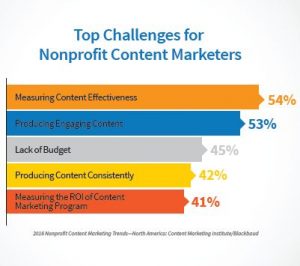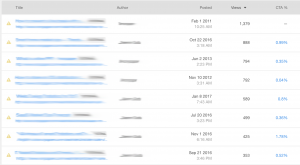
 Nonprofit content marketers struggle with a few top content challenges, according to the Content Marketing Institute/Blackbaud:
Nonprofit content marketers struggle with a few top content challenges, according to the Content Marketing Institute/Blackbaud:
But by performing a nonprofit content audit, you can address these top challenges and make your hard work stretch farther.
Now, many well-meaning articles will tell you to audit all of your content — that is, write down details for every single content piece before you start analyzing. But that can take days or weeks of your valuable time.
Only 26% of nonprofit marketers say their organizations are effective at content marketing. – Content Marketing Institute
Thankfully, there are some simple techniques to perform a fast content audit and discover what works without auditing every single content piece.
What is the purpose of nonprofit content? You could come up with many ideas: To engage, to generate buzz, to inspire, to motivate, to uplift, to showcase your cause.
But above all, we need nonprofit content to impact the organization. All of the other goals are secondary. Because if your articles and content pieces aren't motivating people to take action, you're not growing your cause. And sustainability needs to matter first.
Therefore, for this nonprofit content audit exercise, you can ignore these metrics:
Because, for organizational sustainability, all that matters is which content drove people to action. In other words, we'll only focus on the percentage of readers who clicked on your call-to-action and then converted.
Now that you've eliminated most content metrics and chose just one to focus on, your job to sort content becomes a lot easier.
And if you're using marketing automation tools like HubSpot for your CMS, your job here will be even more easy. (For this exercise, I will use HubSpot for demonstration purposes.)
First, start by auditing your blog. Pull up a list of your blog articles, and sort by "Views," highest to lowest.

In this example (blog titles and author names redacted) in HubSpot's CMS, we can see that the top-viewed blog post has no CTA clicks. In other words, this "top" blog post is getting visitors, but it's not compelling to the audience or motivating them towards action.
Thankfully, there are some simple actions we can take to see more impact.
Tip: Getting back to basics, make sure that all of your blog posts have a call-to-action associated with them. This could be to download a content offer, donate, subscribe to the newsletter, take an advocacy action, etc. This is critical to your nonprofit marketing plan, especially for this audit exercise.
Looking at this list, you should take several actions for a nonprofit content audit:
These are growth-driven strategies that will guide you towards authors, content ideas, and formats that compel your readers to take action with your cause.
You can (and should!) repeat this exercise with your website pages and with any landing pages you have to see what is the most effective. But we chose to start with a blog since you probably have the largest sample size there.
This exercise isn't meant to be an entire content plan for your organization. Of course you want your content marketing to fulfill secondary goals, like inspiration and education.
But for short-term, strategic gains, follow this nonprofit marketing exercise for predictable, successful content ideas.
You should then use these insights to create content for your email marketing campaigns, social media posts, print pieces, and web copy.
With this nonprofit content audit, you'll have a stronger idea of what's actually motivational, not just shareable!
Sources
https://contentmarketinginstitute.com/wp-content/uploads/2015/11/2016_NonProfit_Research_FINAL.pdf
by Jonathan Franchell, CEO of Ironpaper - For more tips and hacks: Need to remove a new line after h1 tags? Both web designers and SEO practitioners need to employ headline tags: H1, H2, H3 in several ways to improve web page structure and tag...

The marketing industry is transforming significantly due to generative AI and increasing market complexity. Gartner's prediction of a 25% decline in traditional search traffic suggests that the era of search engines is dying. AI tools, particularly...

The Crowded Arena of the IT Marketplace Updated December 2024 The Information Technology (IT) landscape is experiencing rapid growth and intensifying competition. IT spending is projected to reach nearly 5.1 trillion U.S. dollars in 2024, a...

Updated December, 2024 The field of digital marketing is evolving rapidly in response to new technology and changing buyer expectations. To help career-minded marketers, we’ve rounded up the top 10 skills needed to succeed in the field. These are...
